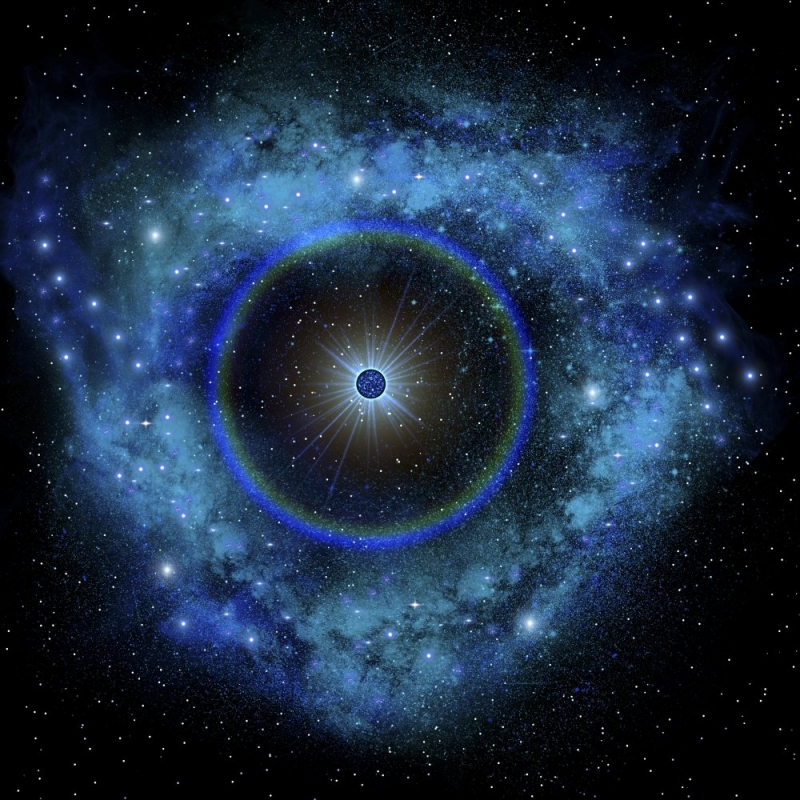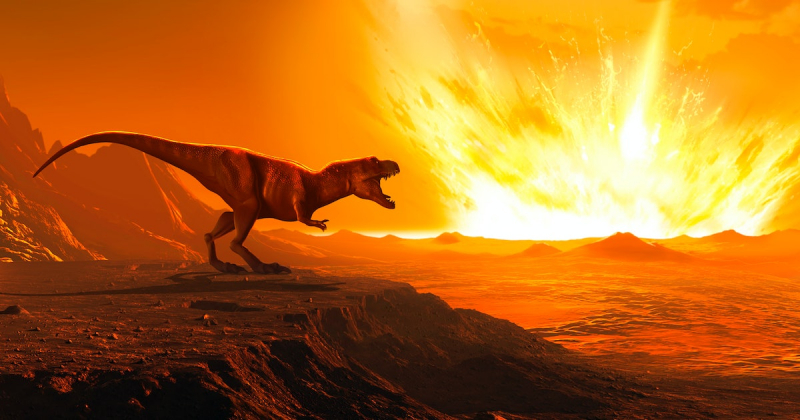Top 10 Energy Equivalents That Put Nature in a Whole New Light
One could argue that the cosmos is so vast that our thoughts will never be able to fully understand it. In fact, it appears highly plausible that even objects ... read more...on Earth are much more advanced than human minds could possibly comprehend. One of the reasons why people may compare floods to 100 Olympic-sized swimming pools or state that something traveled six football fields is because of this. They are all merely means of making something difficult to understand a bit clearer. And it really is mind-boggling how much strength and energy nature has to offer.
-
For a moment, let's move away from the earth because, despite the strength of nature here, the cosmos as a whole puts our little blue dot to shame. As a star erupts in its final moments, let's travel into the emptiness of the great beyond.
This is the largest explosion that has ever been recorded, as far as we know. Additionally, they have the potential to become large. Our attempts to make it seem understandable are still, quite honestly, ridiculously enormous. But it will at least provide some sort of perspective.
A supernova can have an energy discharge of up to 1044 joules. Therefore, the energy released at that single event will equal the energy emitted by the exploding star over the course of its preceding 10 billion years of existence. For a moment, visualize the sun burning as hot and brightly as it does for 10 billion years. We already discussed how much energy is produced every second, enough to last the planet for hundreds of thousands of years. During the supernova, all of that energy that had been stored for 10 billion years was released once more.
We can further break it down because it is still utterly ridiculous and difficult to comprehend. Scientists detected one particular supernova in 2015. The fading star, designated ASSASN-15lh, was 580 billion times brighter than our sun. The tsar bomba, the largest nuclear weapon ever tested, exploded with a detonation that was a billion trillion times more powerful. It was 30 times brighter than the Milky Way galaxy, which has 100 billion stars on its own.- Power releases: 1044 joules

https://www.youtube.com/ 
https://www.walmart.com/ -
Every day, somewhere in the back of our minds, we carry on with the awareness that a meteor may strike the Earth and instantly kill everyone on it. Although unlikely, it has happened before, therefore it is possible that it will do so again in the future. This implies that a meteor must be quite strong when it touches down. To determine how potent they can be, we can examine one from the recent past.
In 2013, a meteor above the Russian city of Chelyabinsk lit up the night sky. The 42,000 mph rock, weighing 11,000 tons, smashed into the air, sending a shockwave that destroyed 4,000 structures. It released energy that was 30 times more than that of the Hiroshima bomb. Strong stuff. But as you may have noted, nothing catastrophic happened.
The meteor that is typically blamed for the extinction of the dinosaurs would be the most well-known meteor in history if we traveled back in time. That one was unquestionably more potent than Chelyabinsk, and the magnitude of its strength was astounding. According to research, the strength of that specific explosion was equivalent to 10 billion bombs detonated during the Second World War. Enough to kill 75% of all life on Earth and sear life millions of kilometers away.- Power releases: 30 times more than that of the Hiroshima bomb

https://www.inverse.com 
https://www.gaia.com/ -
Unnatural disasters like earthquakes can be devastating. The Richter scale is often used to determine the seismic power of an earthquake, yet stating that an earthquake is a four on that scale doesn't actually put anything into perspective. Fortunately, there are some comparisons we can draw.
If an earthquake did measure 4.0 on the Richter scale, you would more or less consider it to be light. Nevertheless, it disperses energy equal to one kiloton of TNT. It seems like a lot, yes? It amounts to approximately 1162 mWh of energy. A 4.0 earthquake could power 108 US households for a year if each US household uses 10.715 kWh on average. However, it was only a light earthquake. Let's move up to a big earthquake.
An earthquake with a magnitude of 9.0 is unusual. That is a significant earthquake, and they only occur occasionally, if ever. The US Geological Survey estimates that they will release energy equivalent to the explosion of 32,000 megatons of TNT. The equivalent in gigajoules is 1,338,880,000,000. That is equivalent to 371,911,111,111.11 in MwH. 4,095,487,406 MwH of electricity are produced in the US. As a result, the 9.0 earthquake produced 90 times as much energy as the US's whole yearly power production capacity.- Power releases: 1162 mWh of energy

https://freedomnationnews.com/ 
https://www.expressandstar.com/ -
Nowadays, everyone is aware of climate change, and the majority of those who still wish to debate it opt for the man vs. nature strategy. That is to say, even the detractors acknowledge that the globe is warming up, but they disagree as to why. But if everyone agrees that the world is warming, how much energy is the planet actually receiving to cause this to happen?
The amount of energy needed to warm the entire world is no minor feat because heat is made up of energy. A very dramatic attempt was made to put it into context by scientists researching global temperature changes.
Scientists compared the earth's energy imbalance between 2005 and 2019. This contrasts the energy we can radiate with the energy we can absorb. In that time, the imbalance increased, and the extra energy the planet is absorbing is equivalent to four Hiroshima explosions taking place per second. This is actually just marginally better than the NASA climate scientist estimate from 2012, which stated that it was equivalent to 400,000 Hiroshimas every day.
- Power releases: 400,000 Hiroshimas

https://www.cnn.com 
https://alumni.nyit.edu -
There have been a few extremely damaging tsunamis in the recent decades. A tsunami with three petajoules of energy struck Japan in 2011. New York City has enough energy to last for a week on that. But even that is insignificant when compared to one from just seven years ago.
The day after Christmas in 2004, an underwater earthquake in the Indian Ocean caused a tsunami. According to estimates, the wave had the same explosive force as 0.8 gigatons of TNT. In more concrete terms, that amounts to 3.35 exajoules, or as much energy as the entire United States of America will consume in 11 days. Exajoules: What the heck are they? That amounts to one quintillion joules.
4,184 joules of energy are produced by one calorie of food. 550 calories are in a Big Mac. This means that 2,301,200 joules are equal to one Big Mac. When the tsunami's exajoules are divided by its total energy, 1.46 trillion exajoules are created. Quite a few Big Macs, in fact.
- Power releases: 4,184 joules

https://www.theverge.com 
https://www.seattlepi.com/ -
Chemical element uranium has the atomic number 92 and the letter U. It is an actinide metal in the periodic table's silvery-gray series. There are 92 protons and 92 electrons in an atom of uranium, of which 6 are valence electrons. All uranium isotopes are unstable, making uranium very mildly radioactive. The half-lives of uranium's naturally occurring isotopes range from 159,200 years to 4.5 billion years.
Uranium-238, which contains 146 neutrons and makes up more than 99% of the uranium on Earth, and uranium-235 are the two most prevalent isotopes in natural uranium (which has 143 neutrons). The element with the largest atomic weight among those found in the early universe is uranium. It is extracted for commercial use from uranium-bearing minerals like uraninite, where it is found naturally in small amounts of a few parts per million in soil, rock, and water.
People have been debating the advantages of nuclear power vs conventional coal burning for a very long time. There are risks associated with nuclear, such as the possibility of meltdowns and the issue of radioactive waste. In contrast, burning coal results in pollution and is incredibly inefficient, as we'll discover shortly.
One kilogram of uranium-235 has the potential to produce 24,000,000 kWh of heat. In contrast, the same weight of coal will yield 8 kWh. In comparison to coal, uranium has a roughly three million times more capacity to produce energy. One ton of coal is equivalent to one single uranium fuel pellet.
- Power releases: 3 Million Times the Heat of 1 kg of Coal

https://cosmosmagazine.com/ 
http://namibianminingnews.com/ -
In the Sunda Strait, between the islands of Java and Sumatra, is the volcanic island of Krakatoa. The area was a part of the Dutch East Indies at the time of its well-known eruption in 1883; it is now a part of Indonesia. The Krakatoa volcano erupted in 1883, creating the loudest sound ever recorded in human history. According to estimates, it was 310 decibels loud—enough to make four complete round of the planet. It was 100 miles away and 172 decibels loud. Standing adjacent to a jet engine will cause you to hear 150 dB of noise.
Ships passing through the busy river began reporting what they had seen, including the German battleship Elizabeth, whose commander saw a cloud of ash over Krakatoa that was almost 6 miles high. By the end of the month, everything had calmed down, although Perboewatan crater continued to spew smoke and ash. It erupted with the explosive power of 200 megatons of TNT. That has a 10,000-fold increase in power over the Hiroshima bomb. Upwards of 36,000 fatalities are estimated.
- Power releases: 10,000-fold increase in power over the Hiroshima bomb

https://oravla.com/ 
https://www.bwallpaperhd.com/ -
Let's start with hurricanes, which have a low-pressure "eye" in the center and several thunderstorms circling it. You are presumably aware of the significant energy release caused by these major tropical cyclones. But how much actually is a lot?
Possibly the most terrible natural phenomenon that any of us will ever experience is a hurricane. We have all seen the evidence of the devastation that hurricanes can do, and their capacity for destruction is difficult to believe. However, how strong is that horrifying force? The enormous magnitude really helps you put things in perspective.
A hurricane will discharge as much energy as 10,000 nuclear weapons from the moment it is created through its cycle of destruction and death. To put it another way, all of that energy—which includes the energy used to build clouds and rain—is equivalent to nearly 200 times the amount of power produced worldwide. Just one hurricane, that. There are several other storms that do not quite qualify as hurricanes, giving us an annual average of roughly six.
- Power releases: 10,000 nuclear weapons

https://buffetoblog.wordpress.com/ 
https://cajunradio.com/ -
Our existence is sustained by the sun's ongoing fusion reaction, which converts hydrogen into helium and generates heat and light. We all want someone will one day perfect fusion here on Earth since it would make life a lot simpler. Fusion is a terrible way to generate power. However, in the meanwhile, we must make do with technologies like nuclear fusion, solar energy, and plain old fossil fuel burning.
When put on the same scale, the differences between fusion and coal burning are so absurd that they appear to be made up. By that, we mean the difference between the amount of coal that must be burned on Earth to provide the same amount of energy as that produced when the sun converts one kilogram of hydrogen into helium.
630 trillion joules, or what you'd get from burning 20,000 tons of coal, are released in the reaction of one kilogram of hydrogen turning into helium. The sun will consume 1.95 x 1029 kg of hydrogen over its lifetime. The sun produces 3.9 x 1026 watts of power in a single second. To put that into perspective, the sun generates more energy in a single second than the entire planet would consume in a few hundred thousand years.- Power releases: 630 trillion joules

https://www.ox.ac.uk/ 
http://www.mrcards.co.uk -
Along with frequent hurricanes, tornadoes, and more than its fair share of earthquakes, North America is prone to all three. There are also several volcanoes here that occasionally erupt, though they are uncommon; one such volcano is Mount St. Helens in Washington state. It demonstrated its incredible strength in horrifying ways when it erupted back in 1980.
'Step Canyon' is this. As opposed to the 1.5km of the real Grand Canyon, which is roughly 20m deeper, Steve Austin has dubbed this the "Little Grand Canyon." Leading into it is "Engineers Canyon," which Wilson adds was constructed quickly by engineers pumping water out of a lahar-dammed lake further upstream. A young Earth (6,000 years or less old) with its geological features formed by the Noachian flood, according to Austin, Morris, and other creationists, is supported by the fact that these two formations were created so quickly by erosive forces. This "proves" the Grand Canyon itself formed extremely quickly.
A series of earthquakes were felt in the region beginning in March of that year, and the volcano itself started to protrude 450 feet. On May 18, it eventually exploded, spewing out 24 megatons of thermal energy, or 24 million tons of TNT. With just the initial lateral blow, it produced 520 million tons of ash and felled enough trees to build 300,000 homes.
- Power releases: 24 megatons of thermal energy

https://www.flickr.com/ 
https://www.earth.com































